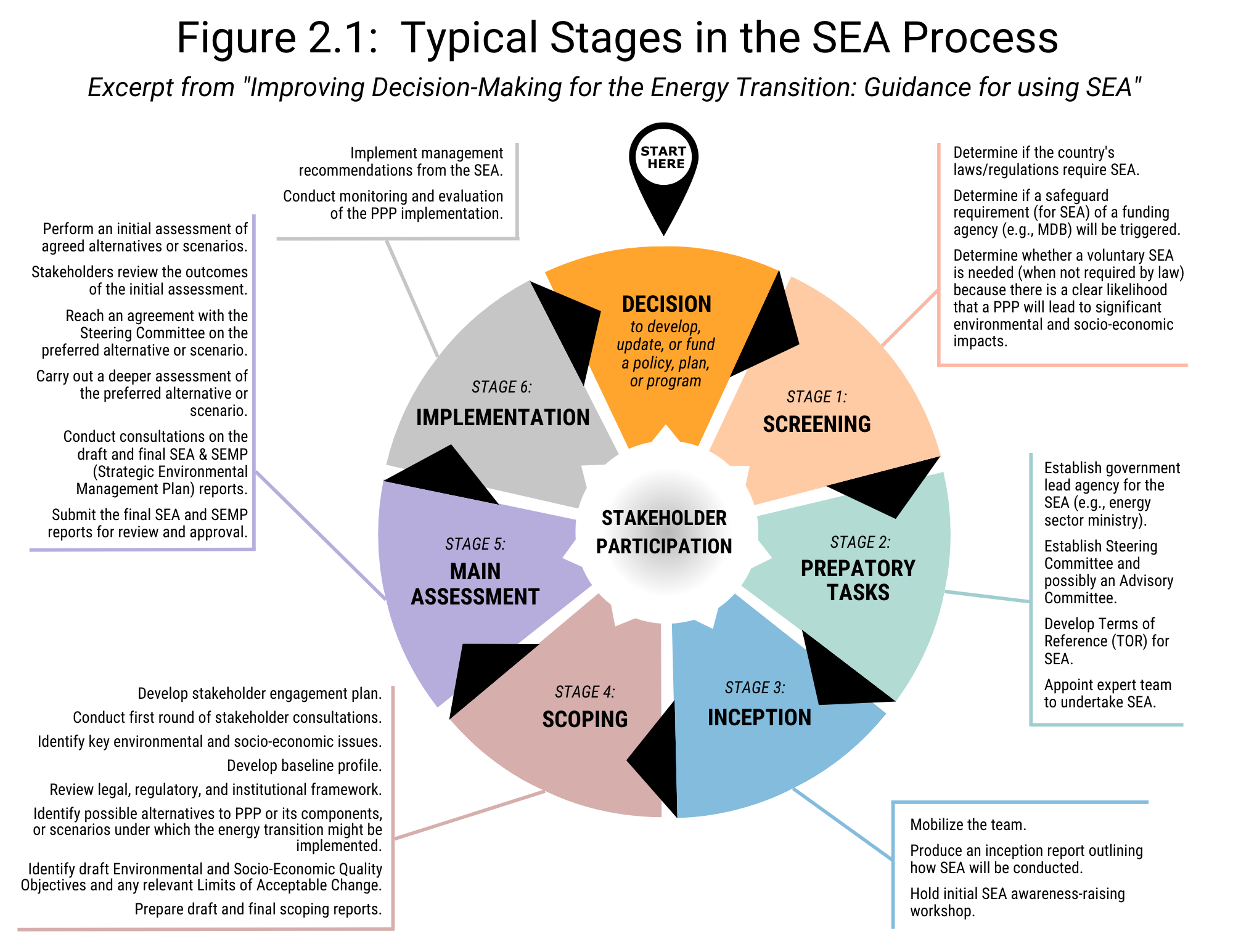Improving Decision-Making for the Energy Transition: Guidance for Using Strategic Environmental Assessment
Chapter 2 outlines the Strategic Environmental Assessment (SEA) process for energy-related policies, plans, and programs (PPP). This involves six main stages: screening, preparatory tasks, inception, scoping, main assessment, and implementation.
There is no single or one-size-fits-all approach to SEA. It should be tailored to the particular needs and circumstances of, and be integrated with, the country’s policy-making and planning system and its legal and governance frameworks. It ensures a focused and comprehensive analysis by drawing on appropriate tools like scenarios, sensitivity mapping, and cumulative impact assessment. The chapter highlights the need to focus on the key environmental and social issues, and for stakeholder engagement throughout the process.

Strategic Environmental Assessments (SEAs) are critical for guiding decisions during the energy transition, ensuring that projects such as renewable energy initiatives consider environmental and social impacts from the beginning. SEA follows several key stages.
The first stage is screening, which checks if an SEA is legally required or needed based on the potential for significant environmental or social impacts.
Next, preparatory tasks are completed. This involves appointing a team of experts, forming a Steering Committee for oversight, and planning how the SEA will be conducted. It’s important that this process is managed by the government or the body responsible for the policy, plan, or program and is designed for transparency and accountability.
The inception phase involves assembling the SEA team, holding initial discussions with the lead organization (usually a government ministry), clarifying the SEA process and terms of reference, and addressing any uncertainties.
The scoping stage identifies key issues that need to be focused on. The team determines the scope of the analysis and gathers baseline information, which might include data on the environment, ecosystems and biodiversity, human health, and socio-economic conditions. At this point, it’s also important to begin engaging with key stakeholders to listen to them and understand their concerns. Stakeholders could include government bodies, the private sector, and civil society (including community groups).
In the main assessment, the team looks at all the possible environmental and socio-economic risks and impacts of the policy, plan, or program (PPP), including alternatives. The likely positive or negative, direct or indirect, cumulative and transboundary effects of implementing the PPP would be considered. This could include looking at habitats and biodiversity, water quality, human health and local communities. The goal is to identify the best option(s) for the PPP while both minimizing environmental and social harm and maximizing benefits.
Once the assessment is complete, the findings are compiled into a SEA report, usually accompanied by a Strategic Environmental and Social Management Plan (SESMP). Both are then subjected to a quality review to ensure they meet high standards and thoroughly cover all necessary elements.
The Strategic Environmental and Social Management Plan (SESMP) should include recommendations to ensure the PPP’s environmental and social effects are monitored and managed throughout its lifetime. To oversee this, clear institutional responsibilities should be recommended. Additionally, a continuous stakeholder engagement process should be established to maintain transparency.
Throughout the entire SEA process, stakeholder engagement is key. Government, businesses and communities all need to be part of the conversation to ensure the PPP reflects their needs and concerns. Public participation ensures the process is inclusive and that decisions are made with input from those who will be directly affected by the PPP.
In summary, SEA is an essential tool for ensuring that energy PPPs (and the development projects the flow from them) not only meet the growing demand for renewable energy but also respect environmental and social considerations. By following a structured process that includes screening, scoping, assessment, and stakeholder engagement, SEAs help make sure that energy projects are sustainable and beneficial for both people and the planet.